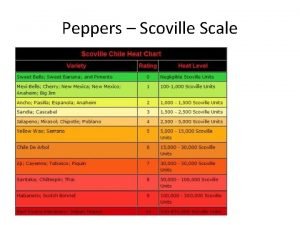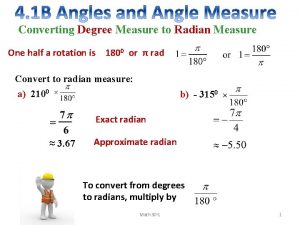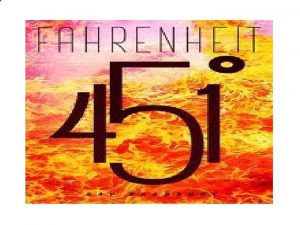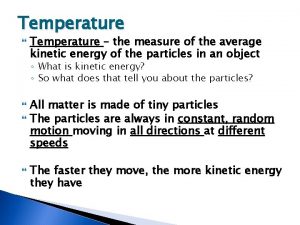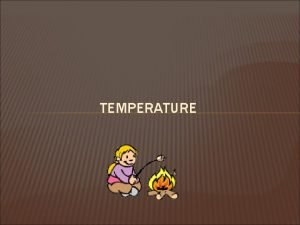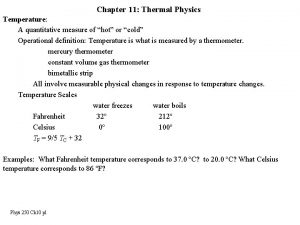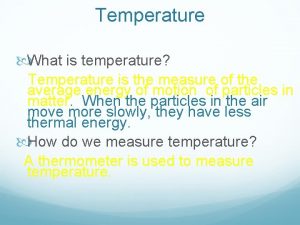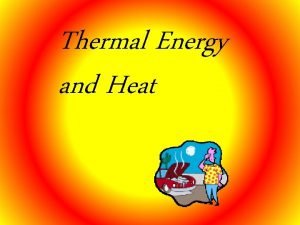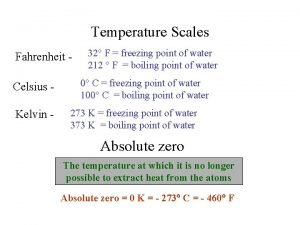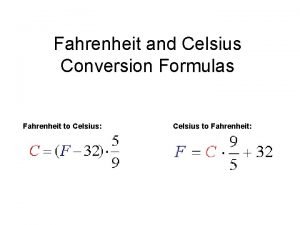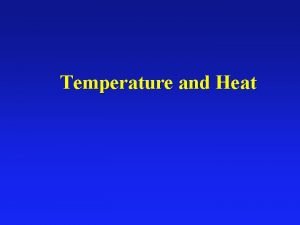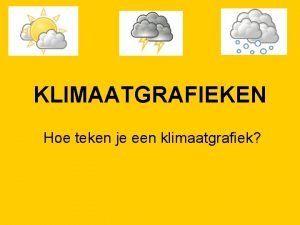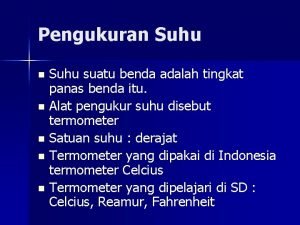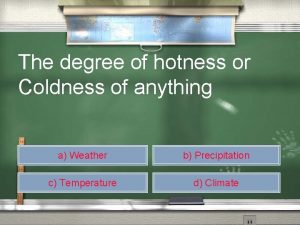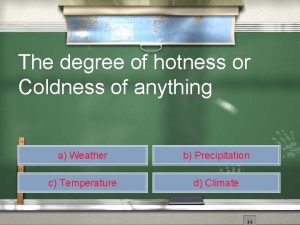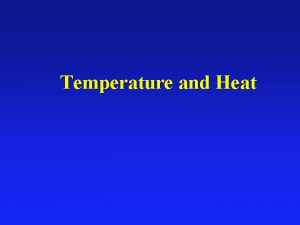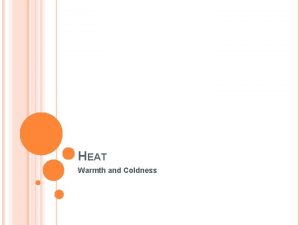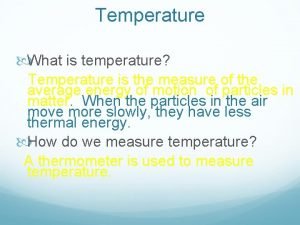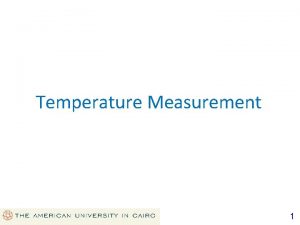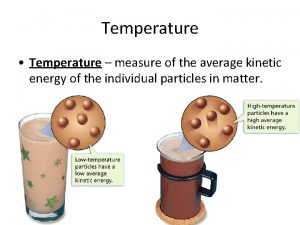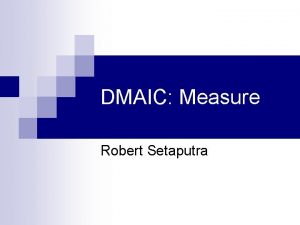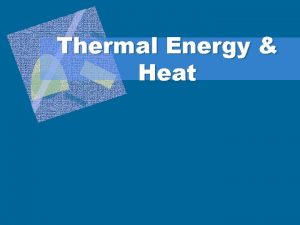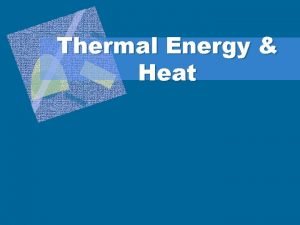Temperature Measure of hotness coldness Degrees Celcius 0























- Slides: 23

Temperature § Measure of hotness / coldness § Degrees Celcius ( 0 C ) Thermometer § All thermometers have a property that changes with temperature § Body Temp : 370 C § Good Indicator of Health

Sound § § § Range of hearing 20 - 20000 Hz 80 d. B danger level : food mixer Stethoscope acts as hearing aid Ultrasound : > 20000 Hz Used to ‘see’ inside body e. g scan womb of pregnant woman

Light / Eye § Refraction : Light changes speed when it travels from one medium to another § Slows down : bends towards the normal § Speeds up : bends away from the normal Glass Angle of Incidence Air Angle of Refraction

Refraction

Focal Length Focal length, f

Convex Lenses The thicker the lens the more powerful the lens and the shorter the focal length

Concave Lenses The thicker the lens the more powerful the lens and the shorter the focal length

The Eye Image is Inverted, Diminished and Laterally Inverted The cornea and lens act together to focus the light.

Distant objects; parallel rays of light; low power lens Close up objects; rays of light spread out; high power lens The Eye

Long Sight § § Distant objects are in focus Close up objects are blurred They are brought to a focus behind retina Convex lens is placed in front of eye

Short Sight § § Close up objects are in focus Distant objects are blurred Brought to a focus in front of retina Concave lens is placed in front of eye

Power of Lens Dioptres, D metres , m

Fibrescope § Fibre Optics : used to see inside body § One bundle carries light into body § Other bundle carries reflected light back to eye of doctor / nurse § Cold light source used

Infra - Red Radiation § I. R. used to treat muscle strains § Hot objects give out I. R. § Cancerous cells are warmer than surrounding healthy ones : show up on thermogram

Ultra Violet Radiation § Needed to produce essential vitamins in body § Exposure can lead to skin cancer § Used to treat acne / skin disorders

X Rays § Blacken photographic plate § Bones absorb x rays but they pass through skin / muscle § CT scan 3 D picture built up / allows precise location of problems

Ionising Radiation § Model of Atom Electrons are around the nucleus somewhere Number of protons equals number of electrons Protons and neutrons in nucleus

Ionising Radiation § Alpha : absorbed by paper / few cms of air § Beta : absorbed by thin metal § Gamma : partially absorbed by lead / concrete § Ionising Radiation KILLS / Changes living cells § Alpha causes most ionisation : adds or knocks electrons off atoms forming charged ions

Ionising Radiation § Used to l kill bacteria on medical instruments l kill cancerous cells l trace blood flow around body

Ionising Radiation § Nucleus decays( breaks up ) giving out ionising radiation § Activity equals the number of nuclei that break up per second. § Units are Becquerels ( Bq)

Ionising Radiation § Half Life : time for Activity to drop to half its original value § Original activity is 100 Bq then after one half life the activity will drop to 50 Bq. After another half life it will drop to 25 Bq and so on.

Half Life Graph Half life is time for activity to fall to half its original value i. e. from 1000 to 500 Bq

Biological effect This depends on § Tissue exposed § Ionising Radiation exposed to § Time exposed for § Energy of ionising radiation Called Absorbed Dose : units Sieverts (Sv) Alpha has greater effect than beta or gamma.
 Barometer
Barometer Hotness song
Hotness song Jigsaw chili scoville
Jigsaw chili scoville Tan120 degree
Tan120 degree One half radian
One half radian Professor faber
Professor faber Difference between curie temperature and neel temperature
Difference between curie temperature and neel temperature Difference between antiferromagnetism and ferrimagnetism
Difference between antiferromagnetism and ferrimagnetism Difference between curie temperature and neel temperature
Difference between curie temperature and neel temperature The measure of average kinetic energy is called
The measure of average kinetic energy is called Temperature is a measure of the average
Temperature is a measure of the average Temperature is a measure of the average:
Temperature is a measure of the average: Is temperature a quantitative measure of heat
Is temperature a quantitative measure of heat Temperature is a measure of *
Temperature is a measure of * Q mct
Q mct Gibbons jacobean city comedy download
Gibbons jacobean city comedy download Penguraian termal aseton pada suhu 600
Penguraian termal aseton pada suhu 600 32 fahrenheit to celsius
32 fahrenheit to celsius Equation for celsius
Equation for celsius Farenheit to kelvin
Farenheit to kelvin Sebuah plat baja berbentuk persegi dengan sisi 30 cm
Sebuah plat baja berbentuk persegi dengan sisi 30 cm Wat is een klimaatdiagram?
Wat is een klimaatdiagram? Penguapan suatu zat dapat dipercepat dengan cara
Penguapan suatu zat dapat dipercepat dengan cara Derajat atau tingkat panas suatu benda dinamakan
Derajat atau tingkat panas suatu benda dinamakan


